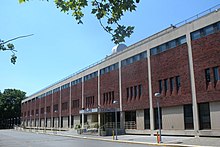Perkins School for the Blind, in Watertown, Massachusetts, was founded in 1829 and is the oldest school for the blind in the United States. It has also been known as the Perkins Institution for the Blind.
Audio description, (AD) also referred to as a video description, described video, or more precisely visual description, is a form of narration used to provide information surrounding key visual elements in a media work for the benefit of blind and visually impaired consumers. These narrations are typically placed during natural pauses in the audio, and sometimes overlap dialogue if deemed necessary. Occasionally when a film briefly has subtitled dialogue in a different language, such as Greedo's confrontation with Han Solo in the 1977 film Star Wars: A New Hope, the narrator will read out the dialogue in character.
The Louisiana School for the Deaf is a state school for deaf and hard-of-hearing students in Louisiana, located in Baton Rouge, the state capital. It was established in 1852 as a joint school for blind students. In 1860, its first purpose-built facility was completed and admired as an elegant monument to philanthropy. The schools were divided in 1898, and in 1908, Louisiana School for the Deaf was renamed.
Service and supports for people with disabilities are those government or other institutional services and supports specifically provided to enable people who have disabilities to participate in society and community life. Some such services and supports are mandated or required by law, some are assisted by technologies that have made it easier to provide the service or support while others are commercially available not only to persons with disabilities, but to everyone who might make use of them.

The Florida School for the Deaf and the Blind (FSDB) is a state-supported boarding school for deaf and blind children established in 1885, in St. Augustine, Florida, United States.
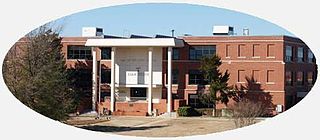
Oklahoma School for the Deaf (OSD) is a public residential school for the deaf and hard of hearing students ages 2 through 18. The school teaches K-12 students in Sulphur, Oklahoma, United States.
The Books for the Blind Program is an initiative of the United States National Library Service for the Blind and Physically Handicapped (NLS) which provides audio recordings of books free of charge to people who are blind or visually impaired. The program has included audio recordings of books since 1934 and digital book efforts began in 1996.
The South Dakota School for the Blind and Visually Impaired (SDSBVI) is a state-supported school located in Aberdeen, South Dakota, which provides services to meet the educational needs of children who are blind, visually impaired, or deaf-blind from birth through the age of 21. SDSBVI has been governed by the South Dakota Board of Regents since 1945.
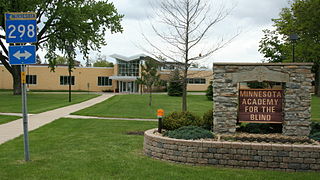
Minnesota State Academy for the Blind (MSAB) (formerly known as the Braille and Sight Saving School) is a public school in Faribault, Minnesota, United States. Its mission is the education and life education of blind, visually impaired, and deaf-blind learners from birth to age 21. The school has a residential option program and provides 24-hour programming including Braille, independent travel, assistive technologies, and individualized educational services. Students often have multiple disabilities and come from all regions of the state.

The California School for the Blind is a public educational institution for blind children, K-12, located in Fremont, California. Its campus is located next to the California School for the Deaf.
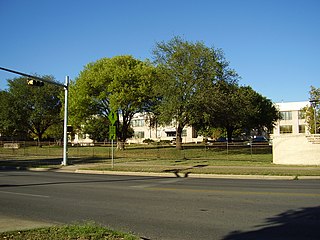
The Texas School for the Blind and Visually Impaired (TSBVI) is a Texas special public school, in the continuum of statewide placements for students who have a visual impairment. It is considered a statewide resource to parents of these children and professionals who serve them. Students, ages 6 through 21, who are blind, deafblind, or visually impaired, including those with additional disabilities, are eligible for consideration for services at TSBVI.

AMI-tv is a Canadian, English-language, digital cable specialty channel owned by the non-profit organization Accessible Media. AMI-tv broadcasts a selection of general entertainment programming with accommodations for those who are visually or hearing impaired, with audio descriptions on the primary audio track and closed captioning available across all programming.

The New Mexico School for the Blind and Visually Impaired is a state special education school with a residential campus in Alamogordo, New Mexico and a preschool in Albuquerque, New Mexico. It operates outreach programs throughout the state.

Disability in the arts is an aspect within various arts disciplines of inclusive practices involving disability. It manifests itself in the output and mission of some stage and modern dance performing-arts companies, and as the subject matter of individual works of art, such as the work of specific painters and those who draw.
Narrative Television Network (NTN) makes movies, television shows and educational programming accessible to millions of blind and visually impaired people and their families. Founded in 1988 by Jim Stovall, the Narrative Television Network unobtrusively adds the voice of a narrator to the existing program between the dialogue so that blind or low vision people can hear what they can't see. The Narrative Television Network has received an Emmy Award, a Media Access Award and an International Film and Video Award for its pioneering work in making movies, television and educational programming accessible for the visually impaired. The Narrative Television Network website offers readers a “Text Only” version of its pages to increase accessibility for blind and visually impaired readers who use screen readers.
The Council of Schools and Services for the Blind (COSB) is a consortium of specialized schools in Canada and the United States whose major goal is improving the quality of services to children who are blind and visually impaired.
AdapTV is the world's first dedicated to the mobility impaired, hearing impaired, and visually impaired. AdapTV initially launched as a network of low power broadcasting stations (LPTV) that all carried the same programming, with the flagship station being KALTV in St. Louis, MO.

Western Pennsylvania School for Blind Children (WPSBC) is a private chartered school in Pittsburgh, Pennsylvania committed to nurturing the unique abilities of individuals with blindness and visual impairment. This multifaceted educational experience serves nearly 500 individuals ages 3 to 59 from 33 counties through on-campus school programs, A Child’s VIEW inclusive childcare, LAVI adult program, residential program and outreach services.

The Twenty-First Century Communications and Video Accessibility Act of 2010 (CVAA) is a United States accessibility law. Signed on October 8, 2010, by then-president Barack Obama, the bill amended the Communications Act of 1934 to include updated requirements for ensuring the accessibility of "modern" telecommunications to people with disabilities.
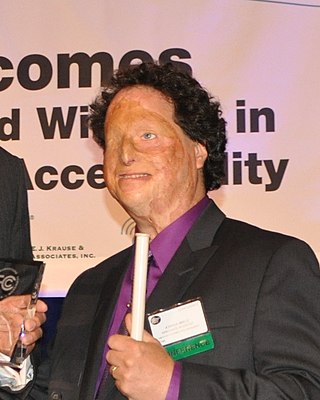
Joshua A. Miele is an American research scientist who specializes in accessible technology design. Since 2019, Miele has been Principal Accessibility Researcher at Amazon Lab126, a subsidiary of Amazon that works on hardware products. Before joining Amazon, Miele conducted research on tactile graphics and auditory displays at the Smith-Kettlewell Eye Research Institute in California for fifteen years. He has been blind since early childhood.
